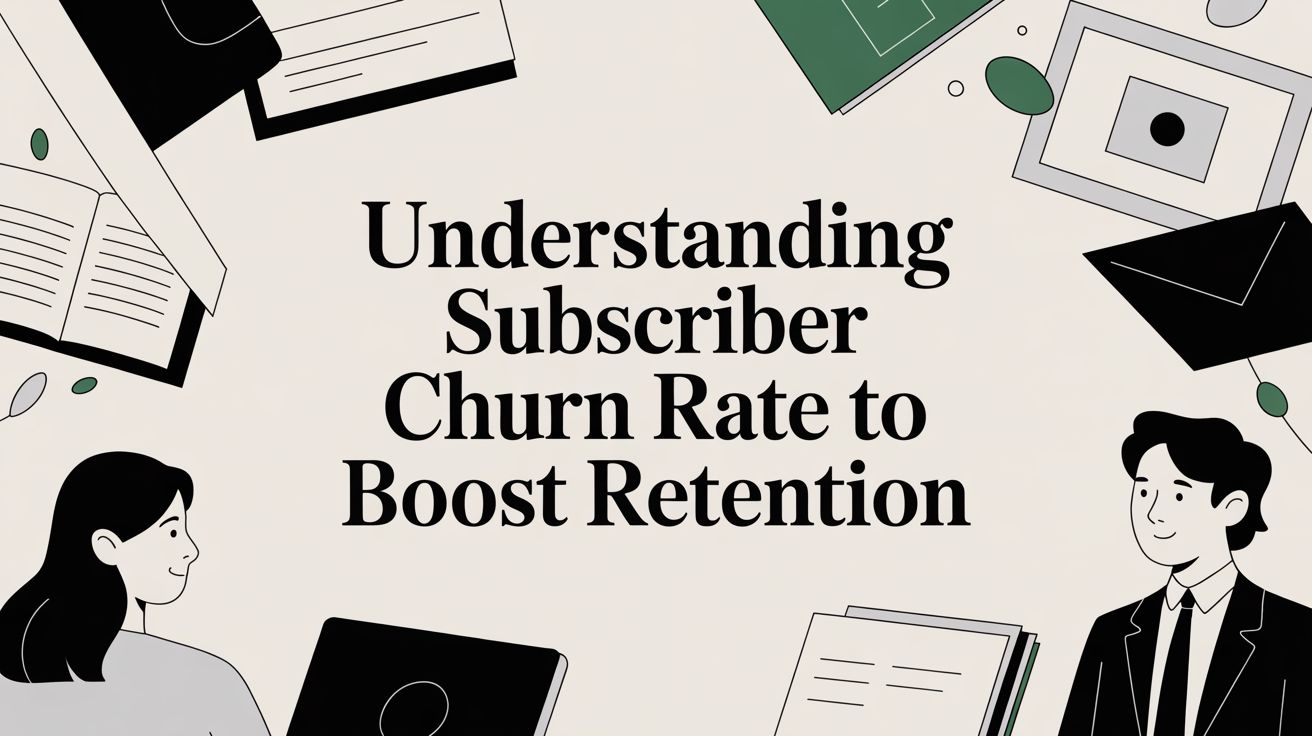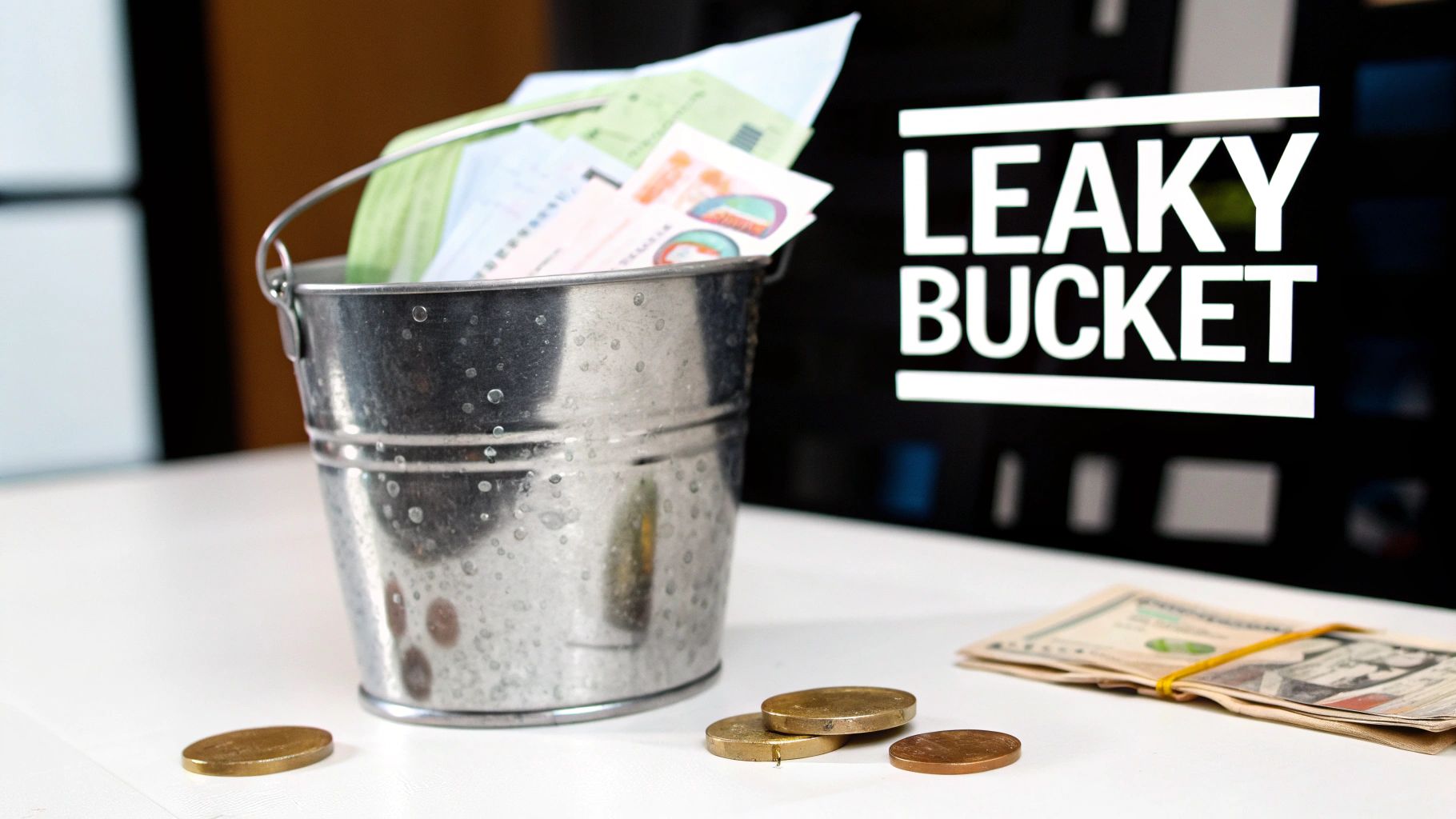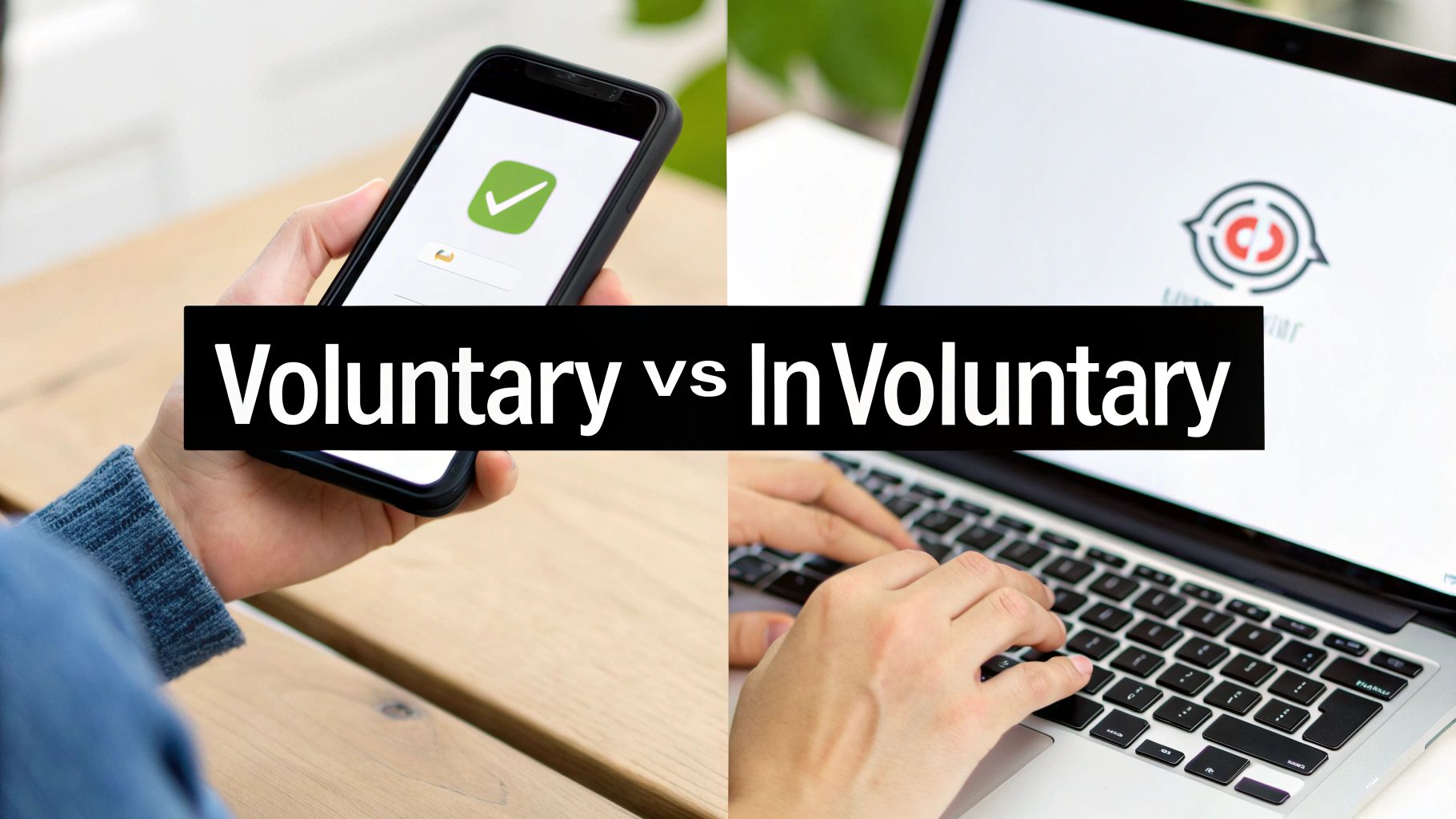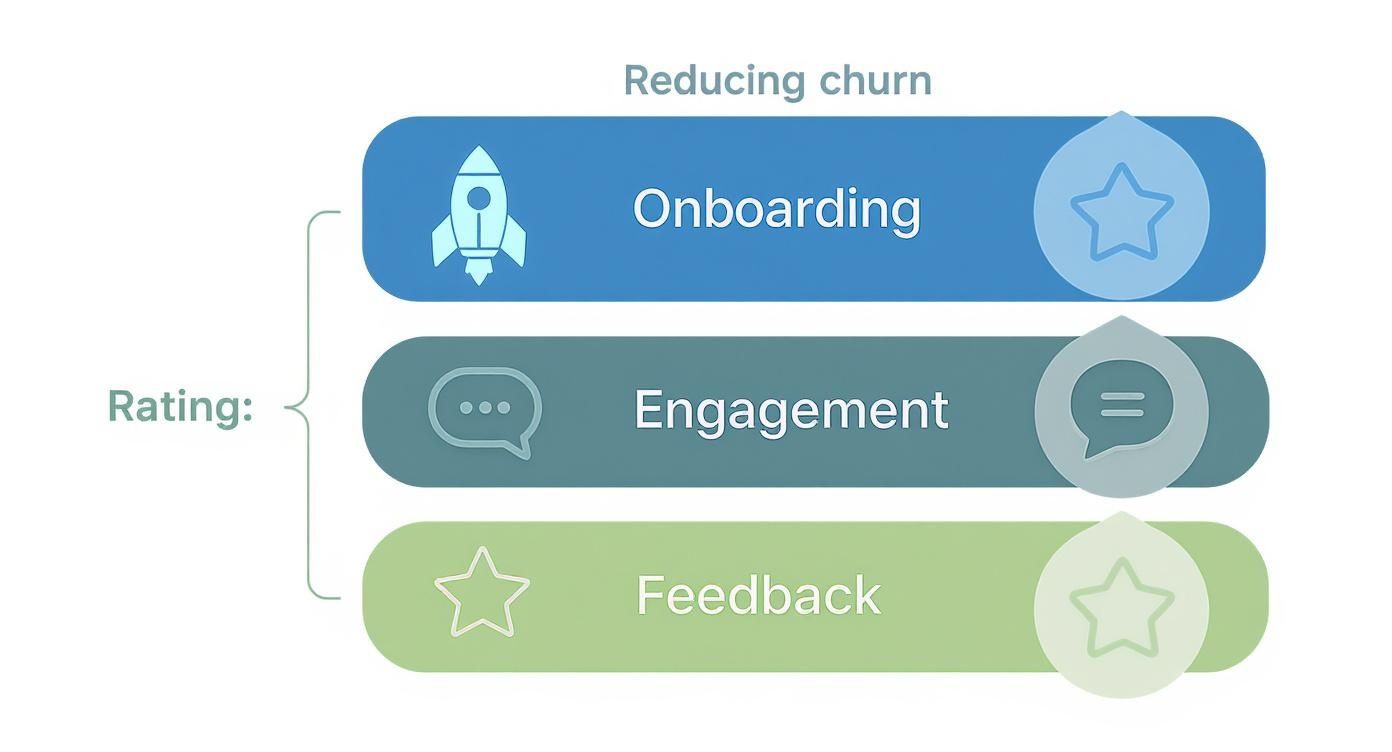
Understanding Subscriber Churn Rate to Boost Retention
Reduce your subscriber churn rate with our complete guide. Learn proven tactics to measure, analyze, and lower churn for sustainable business growth.
Let's talk about a metric that can make or break any subscription business: subscriber churn rate. In simple terms, it's the percentage of customers who hit the 'cancel' button over a certain period. Think of it as the ultimate report card on your business's health and your customers' happiness.
A low churn rate is a beautiful thing—it means your product is sticky and people love what you're offering. But a high rate? That's a red flag waving furiously, telling you something is fundamentally wrong and needs fixing, fast.
Why Subscriber Churn Rate Is Your Most Critical Metric

Let’s get straight to the point. Imagine your business is a bucket, and you’re working day and night to fill it with new subscribers. Churn is the hole in the bottom of that bucket. If that hole is too big, you're losing customers as fast as you can sign them up, turning your growth efforts into an expensive, exhausting treadmill.
For any subscription company, churn isn't just another number; it's a direct pulse check on your viability. It quietly eats away at your profits by driving up your Customer Acquisition Cost (CAC) and torpedoing your customer lifetime value—a key figure for any long-term financial planning. If you want to dive deeper into that, we have a helpful guide to calculating customer lifetime value.
A high subscriber churn rate isn't just a number on a dashboard; it's a direct signal that your product or service is failing to meet customer expectations. Ignoring it is like trying to drive with the handbrake on—you're spending resources but going nowhere.
To quickly grasp the core ideas, here’s a simple table breaking down the key aspects of churn rate.
Key Aspects of Subscriber Churn Rate
| Concept | Brief Explanation | Why It's Important |
|---|---|---|
| Churn Rate | The percentage of subscribers who cancel in a given period. | A direct measure of customer satisfaction and business health. |
| Leaky Bucket Effect | The constant loss of customers undermines growth efforts. | High churn makes growth expensive and unsustainable. |
| Customer Lifetime Value (CLV) | The total revenue a business expects from a single customer. | Churn directly shortens CLV, reducing overall profitability. |
| Diagnostic Tool | Churn data reveals weaknesses in your product or service. | It helps pinpoint issues with onboarding, value proposition, or customer support. |
This table serves as a handy reference, but let's explore why that leaky bucket is so dangerous.
The Leaky Bucket Effect on Growth
That "leaky bucket" analogy isn't just a catchy phrase; it perfectly captures the destructive power of churn. Every single customer you bring in costs you time and money. When they leave, that investment walks right out the door, forcing you to spend even more on marketing and sales just to stand still.
It's a vicious cycle. Growth stalls because all your energy goes into refilling the bucket instead of making it bigger. A low churn rate, on the other hand, is where the magic happens. It allows your growth to compound because each new subscriber adds to a stable, ever-expanding base.
The subscription economy is booming for a reason—consumers stick around when they see real value. In fact, the Subscription Economy Index grew 4.6x faster than the S&P 500 over the last decade. It’s also encouraging to see that average churn rates dropped to 5.4% in 2023, a solid improvement from past years. This shows that the most successful companies are making retention a top priority.
Why You Absolutely Must Track Churn
Getting a handle on your subscriber churn rate is the first step toward building a business that lasts. It gives you honest, unfiltered feedback on the things that truly matter:
- Product-Market Fit: Are you consistently delivering something people find valuable enough to pay for month after month?
- Customer Satisfaction: Beyond the product, are your customers genuinely happy with the entire experience?
- Onboarding Success: Do new users "get it"? Or are they confused and giving up before they see the value?
- Competitive Pressure: Are you losing customers to a competitor, or are other outside forces at play?
When you start monitoring churn, you stop being a victim of it. It transforms from a passive financial drain into an active diagnostic tool, showing you exactly where the cracks are so you can build a stronger, more resilient business.
How to Calculate Your Subscriber Churn Rate Accurately

Don't let the term "churn rate" intimidate you. While it sounds complex, the actual calculation is pretty straightforward once you know what you’re looking at. Nailing this metric is the absolute first step to understanding the health of your subscription business.
Think of it like checking the oil in your car. It’s a simple diagnostic that tells you if things are running smoothly or if there's an issue you need to address before it becomes a bigger problem. An accurate churn rate gives you that same kind of critical insight.
The core idea is simple: what percentage of your subscribers left during a specific timeframe? The biggest mistake I see people make is letting new subscribers cloud the picture. If you don't account for them properly, you'll get a number that looks better than it really is, and that's a dangerous blind spot.
The Standard Churn Rate Formula
To get a clean, honest number, you need to isolate the group of customers you started the period with. This is the only way to measure how many of that specific group decided to leave.
Churn Rate = (Number of Subscribers Who Churned ÷ Number of Subscribers at Start of Period) x 100
Let’s walk through a real-world example to make this crystal clear. Imagine you run a fitness app with a monthly plan and you want to figure out your churn for April.
A Step-by-Step Calculation Example
Let's use our hypothetical app, "FitTrack Premium," and its numbers for the month of April.
Subscribers at the Start of April: You kicked off the month with 10,000 paying subscribers. This is your baseline.
Subscribers at the End of April: On April 30th, you check your dashboard and see 10,200 total subscribers.
New Subscribers Gained in April: Your marketing team did a great job and brought in 700 brand-new subscribers during the month.
So, how many people actually left? You can't just look at the difference between the start and end totals, because those 700 new sign-ups are hiding the real number of cancellations.
Here’s the simple logic to find the true number of churned subscribers:
(Subscribers at Start + New Subscribers) - Subscribers at End = Churned Subscribers
(10,000 + 700) - 10,200 = 500 Churned Subscribers
There it is. 500 subscribers from your original group of 10,000 decided to cancel their plans in April.
Now we just plug that number back into our main formula:
(500 Churned Subscribers ÷ 10,000 Subscribers at Start) x 100 = 5%
Your monthly subscriber churn rate for April is 5%.
Common Pitfalls to Avoid
Getting this calculation right means steering clear of a few common traps. Bad data leads to bad decisions, so precision here is key.
- Forgetting to Isolate New Subscribers: This is the big one we just covered. Including new customers in your starting count will always make your churn look lower than it actually is.
- Inconsistent Time Periods: Comparing last week's churn rate to this month's is like comparing apples and oranges. You have to stick to consistent intervals—monthly or quarterly—to spot genuine trends.
- Confusing Customer Churn with Revenue Churn: Losing ten people on a $5/month plan is a completely different problem than losing one enterprise client paying $5,000/month. You should absolutely track revenue churn as a separate metric to understand the financial impact of cancellations, especially if you have different pricing tiers.
By using the right formula and avoiding these mistakes, you get a churn metric you can actually trust. It becomes a reliable compass for guiding your product improvements and customer retention strategies.
Getting to the "Why" Behind Subscriber Churn

Not all churn is the same. Far from it. A customer canceling because they found a better deal presents a totally different challenge than one whose credit card just happened to expire. If you don't separate them, you’ll end up wasting time and money on the wrong fixes.
To get a real handle on retention, you need to split your subscriber churn rate into its two main categories: voluntary churn and involuntary churn. Think of it as the difference between a deliberate breakup and an accidental disconnection. One requires you to prove your value, while the other just needs a quick technical fix.
Voluntary Churn: The Conscious Decision to Leave
Voluntary churn, also called active churn, is what most of us picture when we hear about a customer leaving. It’s when a subscriber consciously decides to end their relationship with your service—they log in, go to their account, and click "cancel."
This kind of churn is a direct report card on your product and the experience you provide. It’s a customer raising their hand to say, "This isn't for me anymore."
So, why do they do it? The reasons are often very personal, but they usually fall into a few key buckets:
- A Better Offer Elsewhere: A competitor might have a killer feature, a lower price, or just a slicker experience that lures them away.
- The Value Fades: The customer no longer feels like what they're paying matches what they're getting. This often points to a weak onboarding process or a failure to highlight new features and benefits over time.
- A Bad Experience: One frustrating interaction with customer support can be the final straw. In fact, some studies show that a staggering 68% of cancellations can be linked to slow or unhelpful service.
- Life Simply Changes: Their needs evolve, their business pivots, or they just don't need your solution anymore.
Tackling voluntary churn means digging deep into the "why." It's your cue to take a hard look at your product, pricing, and customer service.
Involuntary Churn: The Accidental Goodbye
Then you have involuntary churn, or passive churn. This is when a customer disappears without ever meaning to, almost always because of a failed payment. They didn't want to leave; a simple technical glitch showed them the door.
Involuntary churn is the silent killer of subscription revenue. It’s easy to overlook but can account for a shocking 20-40% of total churn for many businesses. The upside? It's almost entirely preventable.
The main culprits here are usually pretty simple:
- Expired Credit Cards: This is the big one. The card on file simply hits its expiration date.
- Hard Declines: The bank flags a transaction for potential fraud or because the card was reported lost or stolen.
- Soft Declines: These are temporary hiccups, like insufficient funds or a card hitting its credit limit for the month.
Fighting this type of churn isn't about winning back a customer's heart—it's about fixing a broken process. This is where tools for dunning management (the automated emails that chase failed payments) and services that automatically update card details become your best friends.
Voluntary Churn vs Involuntary Churn
Understanding this split is critical because you can't solve both problems with the same strategy. You wouldn't offer a discount to fix an expired credit card, and you wouldn't add new features to win back someone who had a terrible support experience.
This table breaks down the core differences at a glance:
| Attribute | Voluntary Churn (Active Cancellation) | Involuntary Churn (Passive Cancellation) |
|---|---|---|
| Customer Intent | The customer actively chooses to leave. | The customer is lost due to an accident. |
| Primary Cause | Value gap, competition, poor experience. | Payment failures (expired card, etc.). |
| Typical Solution | Improve product, enhance onboarding, offer incentives. | Implement dunning management, card updaters. |
| Customer Emotion | Dissatisfaction, frustration, or indifference. | Unaware, surprised, or annoyed by the interruption. |
By separating these two types of churn, you can finally stop guessing. You can build targeted, effective strategies that address the real reasons you’re losing subscribers and turn a painful metric into a powerful roadmap for growth.
Finding the Root Causes of High Subscriber Churn
Calculating your churn rate tells you what is happening—the raw percentage of customers walking out the door. But to actually solve the problem, you have to dig into the why. Figuring out the root causes of churn is a bit like detective work; you have to follow the clues to understand the motive behind every cancellation.
Subscribers rarely leave on a whim. Their decision is usually the final step in a long journey of small frustrations, unmet expectations, or a slow realization that they just aren't getting enough value. It’s not about one bad day; it’s about a relationship that quietly soured over time.
Your job is to spot these friction points before they become deal-breakers. Whether it’s an obvious issue like a high price tag or a subtle one like a confusing onboarding flow, each negative experience chips away at loyalty until a customer finally decides it’s not worth it anymore.
The Most Common Churn Drivers
While every business has its own quirks, the reasons customers leave tend to fall into a few familiar buckets. Knowing these common culprits is the first step in diagnosing your own churn problem. Think of it as a checklist of potential weak spots to investigate in your customer's journey.
Let's look at the most frequent reasons behind a high subscriber churn rate.
- A Rough Onboarding: If new users don't get that "aha!" moment or see your product's value quickly, they lose steam and quietly drift away. A confusing or overwhelming first impression is one of the biggest reasons for early-stage churn.
- Lack of Perceived Value: This one is a silent killer. The customer isn't necessarily unhappy, but they just don't feel the subscription is worth the monthly cost. Maybe they aren't using the key features, or they've simply forgotten why they signed up in the first place.
- Product or Service Flaws: Bugs, downtime, and missing features are obvious deal-breakers. If your product doesn’t deliver on its promises reliably, customers will start looking for a more stable alternative.
- Price vs. Value Mismatch: Your price might be too steep for what you offer, or a competitor may have swooped in with a more compelling deal. This forces customers to take a hard look at their budget and your place in it.
Digging into these areas requires some honest self-reflection. Are you really delivering an experience that justifies the price you charge, month after month? For a more exhaustive list of potential problems, it's worth reviewing these common subscription cancellation reasons that trip up many businesses.
The Critical Role of Customer Service
Of all the things that can drive customers away, one consistently does the most damage: poor customer service. A single frustrating support interaction can erase months, or even years, of loyalty in an afternoon. It’s not just about solving the problem; it’s about how you make the customer feel while you're solving it.
Feeling ignored is often worse than the original issue. In fact, one of the most eye-opening findings from recent research is that a staggering 68% of customer cancellations are tied directly to slow or poor response times. This makes support responsiveness absolutely critical for retention. The data gets even more specific: customers who wait more than two hours for a reply are 4x more likely to churn, while 89% of customers say a quick response makes them more loyal.
The speed of your response is often more important than the speed of the resolution. A customer who feels heard and acknowledged right away is far more likely to be patient, even if the actual fix takes a little longer.
How to Start Your Investigation
So, you know what to look for. How do you find these problems lurking in your own business? The best way is to mix hard numbers with human stories—quantitative and qualitative data. You need the data to spot patterns and the stories to understand the "why" behind them.
- Conduct Exit Surveys: The moment a customer cancels, ask them why. Keep it short and sweet, focusing on the main reason they left. This is your most direct line to the truth.
- Analyze Support Tickets: Your support inbox is a goldmine. Sift through conversations to find recurring complaints, common points of confusion, and popular feature requests.
- Talk to Your Customers: Go beyond surveys. Have real conversations with both happy customers and those who have left. Ask open-ended questions to understand what they love, what drives them crazy, and what they wish was different.
- Review Product Usage Data: Look at what your churned users were doing—or, more importantly, what they weren't doing. If they never engaged with your key "sticky" features, that's a huge red flag.
By combining these methods, you can stop guessing and start knowing. You’ll build a crystal-clear picture of what’s pushing subscribers away, allowing you to finally fix the root causes of your churn instead of just patching up the symptoms.
Ready to Fight Churn? Here’s How to Take Action
Knowing what makes customers leave is half the battle. The other half? Rolling up your sleeves and actually doing something about it. This is where you move from spreadsheets and analysis to action—turning insights into real-world retention and protecting your revenue.
Reducing your subscriber churn rate isn’t about finding a single magic bullet. It’s a combination of proving your value over and over, building real relationships, and sanding down any rough edges in the customer experience. Think of it less like a one-time fix and more like a continuous commitment to making your service indispensable. These tactics aren't just damage control; they're about creating an experience that customers genuinely don't want to leave.
Nail Your Onboarding
First impressions are everything. Those first few days a new customer spends with your product are make-or-break. A clunky, confusing, or underwhelming onboarding process is one of the fastest tickets to early churn. If customers don't get that "aha!" moment quickly, their initial excitement will fizzle out, and they'll quietly drift away.
Your mission is to guide new users to a quick win. A killer onboarding experience should:
- Celebrate the First Victory: Get users to complete one key action that immediately shows off your product’s core value.
- Offer Help in Context: Ditch the generic, one-size-fits-all product tour. Instead, provide helpful tips and guidance as users explore features for the first time.
- Set Clear Expectations: Let new customers know exactly what they need to do to succeed and what they can expect from you along the way.
Keep Customers Engaged and Informed
Getting a customer signed up is just the beginning. The real work is in the ongoing engagement that keeps your service top-of-mind and constantly reinforces its value. When people feel confident using your product and understand all the ways it can help them, they’re far less likely to look elsewhere.
This is where relationship marketing comes in—building loyalty through consistent, helpful communication. In fact, research shows that 68% of users are more loyal to businesses that invest in teaching them how to succeed. This isn’t about spamming their inbox; it’s about delivering timely, relevant content that helps them achieve their goals.
"Churn often comes from a place of uncertainty: 'Am I doing this right?' 'Is this worth the money?' 'Am I even using all the features I'm paying for?' Proactive education turns that hesitation into confidence—and confident customers stick around."
A great communication strategy could include webinars on advanced features, blog posts sharing best practices, or case studies that inspire them with what’s possible. The goal is to be a partner in their success, not just a service provider.
Systematically Gather and Act on Feedback
Your customers are constantly telling you how to keep their business. You just have to listen. Building formal channels to collect feedback is one of the most powerful things you can do to reduce your subscriber churn rate. When people feel heard, they feel valued.
Don't wait until they've already canceled to ask what went wrong. Set up a system to gather insights at every stage of their journey:
- The Exit Survey: The moment someone cancels, ask them why. Keep it super short—just one or two questions—to get the highest response rate.
- In-App Feedback: Give users an easy way to report a bug or suggest a feature without having to leave your app. Tools like Hotjar or UserVoice are great for this.
- Net Promoter Score (NPS) Surveys: Regularly send out NPS surveys to measure overall customer loyalty. This helps you spot unhappy customers (detractors) before they walk out the door.
But the most critical step of all is to close the loop. When you implement a change based on feedback, tell everyone about it! Announcing that you’ve fixed a bug or added a requested feature shows customers that their voice matters. It turns complaints into proof that you’re committed to making their experience better, building incredible loyalty in the process.
What’s a “Good” Churn Rate, Anyway? Industry Benchmarks Can Tell You
So, you’ve done the math and calculated your subscriber churn rate. But what does that number on your screen actually mean? Is a 5% monthly churn a reason to celebrate, or is it a five-alarm fire? The honest answer is: it depends.
Without context, your churn rate is just a number floating in space. To make it meaningful, you need to compare it to industry benchmarks. This gives you a frame of reference to understand if you’re performing well, just keeping pace, or falling behind the competition. Think of it as a reality check—are you dealing with a unique problem, or is this just the cost of doing business in your sector?
The infographic below breaks down some of the most critical areas to focus on for keeping customers around, like nailing your onboarding process and actively listening to feedback.

As you can see, a solid retention strategy is about the entire customer journey, not just a single moment in time.
How Churn Varies Across Different Industries
Churn is definitely not a one-size-fits-all metric. A B2B SaaS company that signs massive enterprise contracts will naturally have a much different churn profile than a direct-to-consumer meal kit service. Some industries are just more volatile by nature, often due to fierce competition and low switching costs for customers.
For instance, some sectors struggle with much higher turnover. Financial services and cable companies often top the charts with churn rates around 25%. General retail and online retail aren't far behind at 24% and 22%. On the other end of the spectrum, the travel industry keeps churn closer to 18%, and big box electronics retailers have it even better at just 11%.
Don't be fooled by a low monthly number. A 5% monthly churn seems small, but it compounds over time. After just one year, you’ll have lost nearly half (46%) of your customers.
This is a gut-punch of a stat, but it perfectly illustrates why even tiny improvements in retention can completely change the long-term health of your business. It's also why meticulously tracking all of your key subscription business metrics is non-negotiable.
Use Benchmarks as a Guide, Not a Strict Rule
While industry data is a fantastic starting point, it's a huge mistake to treat these numbers as gospel. Your own unique situation matters. A lot.
Before you panic (or get complacent), think about a few things that can color what a "good" churn rate looks like for you:
- Business Age: Are you a startup or an established player? Younger companies almost always have higher churn because they're still figuring out their product-market fit. A well-known brand should be aiming much lower.
- Target Customer: Selling to small businesses is a different ballgame than selling to enterprise clients. SMBs are just naturally more likely to churn, whereas big corporate contracts tend to be much stickier.
- Pricing Model: A low-cost, high-volume subscription will see different churn patterns than a premium, high-touch service.
Ultimately, the best benchmark is your own historical data. The real goal isn't just to beat an industry average; it's to see a steady, downward trend in your own churn rate over time. Use the industry numbers to set your initial goals, but let your own progress define your success.
Digging Deeper: Common Questions About Subscriber Churn
Once you get a handle on the basics of subscriber churn, a few more specific questions almost always pop up. Let's tackle some of the most common ones to clear up any lingering confusion and help you put this knowledge into practice.
What Is a Good Monthly Subscriber Churn Rate, Really?
There’s no magic number here. A “good” monthly churn rate completely depends on who you're selling to, what industry you're in, and how mature your business is.
For SaaS companies catering to small and medium-sized businesses, a churn rate in the 3-5% ballpark is often considered acceptable. But if your focus is on large enterprise clients with massive contracts, you should be aiming for something much lower—ideally below 1%.
In the B2C world, think streaming services or subscription boxes, keeping churn under 5% is a solid goal. The best advice? Find your industry's average as a starting point, but then obsess over beating your own numbers every single month. Your most important benchmark is your own past performance.
How Often Should I Be Calculating Churn?
For most companies, running the numbers on a monthly basis is the sweet spot. It's frequent enough to catch problems before they spiral out of control, but not so frequent that you're getting whiplash from normal day-to-day fluctuations.
That said, a monthly calculation is just one piece of the puzzle. It's smart to look at churn through different lenses:
- Monthly: Perfect for making tactical tweaks and seeing what's happening on the ground.
- Quarterly & Annually: Crucial for big-picture strategic planning and understanding the long-term health of your customer relationships.
This combination gives you both the close-up view and the panoramic perspective you need to manage retention effectively.
Is It Possible for Churn to Be Negative?
Absolutely, and it's the holy grail for any subscription business. Hitting a negative churn rate is a powerful sign that you've built something customers genuinely love and are willing to pay more for over time.
Negative churn occurs when the new revenue from your existing customers (think upgrades, expansion packs, or new features) is greater than the revenue you lose from the customers who cancel in that same period.
In simple terms, you're making more money from your current user base than you're losing. This means your company can grow even if you don't sign up a single new customer. It’s the clearest signal that your product is essential and that you're successfully growing with your customers, creating a powerful engine for sustainable growth.
Ready to turn churn insights into action? Nuxie provides the tools to design, test, and ship high-converting paywalls that keep subscribers engaged and happy. Stop guessing and start growing your app's revenue today. Learn more at Nuxie.io.